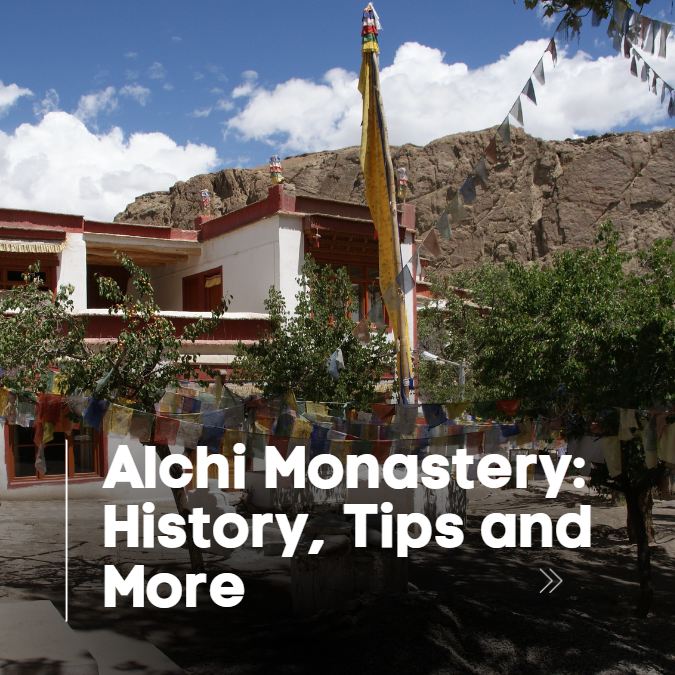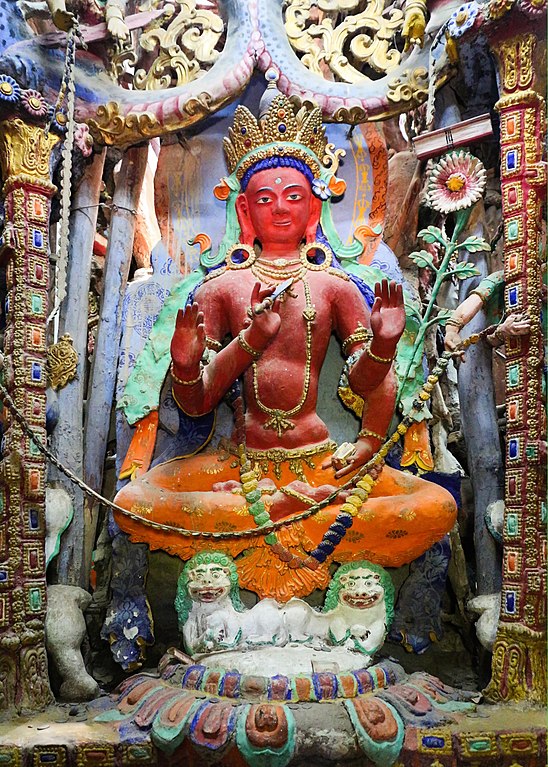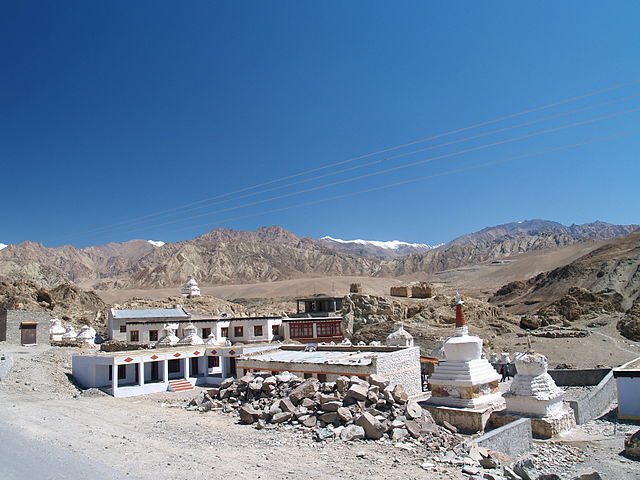Table of Contents
Have you ever wondered what it would be like to step back in time and witness ancient architecture come to life? If so, the Alchi Monastery is a must-see destination. Located in the quaint village of Alchi in Ladakh, India, this small monastery complex is a true marvel that offers an unforgettable glimpse into history. Surrounded by the stunning Himalayan region, this ancient monastery was built in the 11th century by the Arya people. Its intricate mandala designs are a testament to the exquisite craftsmanship of the time. For those seeking a unique cultural experience in Himachal Pradesh, a visit to the Alchi Monastery is a must.
Built-in the 11th century by the monks of the Alchi group, the Alchi complex consists of three main structures: the Assembly Hall, Sumtsek Temple, and Manjushri Temple. Additionally, there is a small monastery nearby called Likir Monastery that visitors can also explore. Each building boasts unique features, such as intricate mandalas, that make them standout attractions for visitors from all over the world.
The Assembly Hall is a building of a monastic complex with intricate details and high ceilings. The ground floor was used for religious gatherings while the upper floor was reserved for meditation and study. Meanwhile, the Sumtsek Temple, located in a small monastery, is a three-story structure that houses some of the oldest surviving murals in Ladakh. Finally, there’s Manjushri Temple – a single-story structure featuring a statue of Manjushri, Bodhisattva of Wisdom, depicted in a mandala.
But what makes this monastery complex so special? It’s not just about its stunning architecture or rich history. It’s also about how it brings together different elements to create something truly unique – something that can’t be found anywhere else. The complex is located in Alchi village and houses the famous Alchi murals, which depict the life of Buddha in intricate detail. Visitors can marvel at the beauty of these ancient images while learning about the spiritual teachings of the Arya tradition.
When you visit Alchi Monastery, a historic monastic complex, you’ll get to experience firsthand how religion and culture have intertwined over centuries to create something beautiful. You’ll see how these monasteries were built by Arya monks who dedicated their lives to preserving their beliefs through art and architecture. The Sumtseg, or three-storied temple, is a must-see attraction where you can witness the intricate details of the lama’s craftsmanship.
So if you’re looking for an adventure that will transport you back in time while also offering breathtaking views and insights into ancient cultures, the Alchi Monastery is the perfect destination for you! This monastic complex, founded by the Arya lama Rinchen Zangpo, is home to the stunning Sumtseg temple.
History of Alchi Monastery: A Glimpse into the Rich Cultural Heritage of Leh Ladakh
Alchi Monastery is a historic Buddhist temple located in the Ladakh region of India. This ancient monastery was built in the 10th century by the great translator Rinchen Zangpo, an Arya, and is considered one of the oldest monasteries in Ladakh. It is situated on a hilltop overlooking the Indus River, surrounded by stunning Himalayan mountains. The lama group at Alchi Monastery is known for their spiritual teachings and practices, attracting visitors from all over the world. At an elevation of over 3,000 metres, the monastery offers breathtaking views of the surrounding landscape.
The Oldest Monastery in Ladakh
Alchi Monastery, located in Ladakh, India, stands out as one of the most significant religious sites in the region. It is renowned for its rich cultural heritage and unique architectural style, which reflects a blend of Indian and Tibetan influences. The monastery is situated at an altitude of 3,100 metres (10,171 ft) above sea level and is also known as Alchi Gompa.
The monastery, known for its ancient Alchi murals, has three major temples – Du-Khang, Sumtsek, and Temple of Manjushri – each with its own distinct style and significance. The Du-Khang temple houses an impressive statue of Vairocana or Dharmakaya Buddha, while the Sumtsek temple has three-tiered images of Maitreya Buddha. The Temple of Manjushri is considered an Arya temple.
Intricate Artwork by Kashmiri Artists
One of the most remarkable features of Alchi Monastery is its intricate wood carvings and wall paintings that adorn every inch of its walls. These artworks are considered some of the finest examples of Kashmiri art from that era. It is also worth noting that the monastery holds significance in the Arya tradition.
The murals depict scenes from Buddhist mythology as well as daily life during those times. They are painted using natural pigments made from minerals such as lapis lazuli, malachite, indigo, and ochre mixed with animal glue. These Arya murals are truly a sight to behold.
Jampe Lhakhang: A Three-Story Statue
The Jampe Lhakhang temple at Alchi Monastery is another highlight that draws visitors from all over the world. This temple features a massive three-story statue of Maitreya Buddha, who is also known as Arya Maitreya, that towers over visitors.
The Alchi complex houses a statue made of clay and wood believed to have been built by a Kashmiri artist commissioned by Rinchen Zangpo. Alongside several smaller statues of deities and saints, the temple features stunning Alchi murals and is considered an important site for Arya practitioners.
Galdan Namchot Festival: A Celebration of Light
The Galdan Namchot festival, celebrated in December, is one of the most important festivals at Alchi Monastery. This festival marks the birthday of Tsongkhapa, the founder of the Gelugpa school of Tibetan Buddhism and an Arya.
During this festival, the entire Alchi complex is decorated with lights and colourful banners, showcasing the breathtaking Alchi murals. People come from all over Ladakh, including the Arya community, to celebrate this event, which includes traditional dances, music performances, and feasting.
The Architecture of Alchi Monastery: A Marvelous Blend of Indian and Tibetan Styles
Alchi Gompa, located in the Himalayan region of India, is an Arya monastic complex known for its unique blend of Indian and Tibetan styles of architecture. The temple complex at Alchi Gompa consists of several temples, including the Manjushri Temple, which is dedicated to the bodhisattva of wisdom and features intricate mandalas.
The Influence of Rinchen Zangpo on Alchi Monastery’s Architecture
The architecture at Alchi Gompa reflects the influence of Rinchen Zangpo, an Arya, a famous translator and scholar who brought Buddhism to the region in the 10th century. Zangpo was responsible for building many Buddhist monasteries in this area, including Alchi Gompa. He was also instrumental in translating Buddhist texts from Sanskrit into Tibetan.
Zangpo’s influence on Alchi Monastery’s architecture can be seen in its unique blend of Indian and Tibetan styles. For example, some of the murals at Alchi Gompa are similar to those found in Kashmiri temples from that time period. Some scholars believe that there may have been an exchange between Kashmiri artists and Tibetan artists during this time.
The combination of Indian and Tibetan Styles Creates a Distinctive Aesthetic
The combination of Indian and Tibetan styles at Alchi Gompa creates a distinctive aesthetic that is both beautiful and significant in the history of Tibetan Buddhism. The fusion between these two styles resulted in a new form that became known as “Indo-Tibetan” art.
One example of Indo-Tibetan art at Alchi Gompa is the Manjushri Temple. This temple features intricate mandalas that are typical of Tibetan Buddhism but also incorporate elements from Hinduism. Another example is the Sumtsek Temple, which has three stories and is decorated with murals that depict scenes from the life of Buddha.
The unique blend of Indian and Tibetan styles at Alchi Gompa also reflects the cultural exchange that occurred between India and Tibet during this time period. This exchange was not limited to art and architecture but also included philosophy, religion, and language.
Answering the Question: Why Are All Monks Male?
While discussing the architecture of Alchi Monastery, it’s worth addressing a common question about Buddhist monasteries: why are all monks male?
The answer to this question is complex and varies depending on the specific tradition or sect of Buddhism in question. However, one reason for this is that historically, women were not allowed to become fully ordained as Buddhist nuns. While there were some exceptions to this rule, such as in certain regions of China or Japan, overall women have been excluded from full ordination in many Buddhist traditions.
This exclusion has been attributed to various factors over time, including social norms regarding gender roles and expectations as well as concerns about maintaining a pure sangha (community of monks). In recent years, there have been efforts within some Buddhist communities to challenge these norms and allow for greater gender equality within the monastic community. However, the ancient Alchi murals in Ladakh still depict traditional gender roles and may perpetuate these norms.
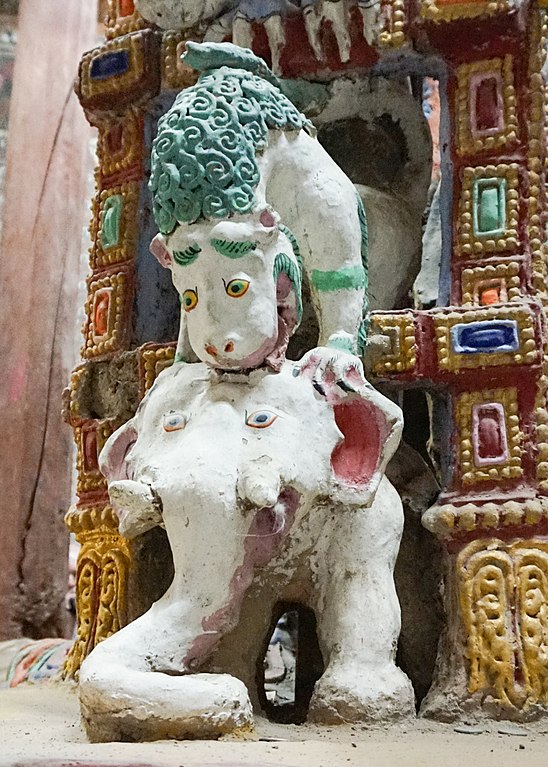
Best Time to Visit Alchi Monastery: Climate, Festivals, and Crowds
Ideal Months for Visiting Alchi Monastery
The best time to visit Alchi Monastery is from May to September when the weather is pleasant and the roads are accessible. During these months, visitors can enjoy clear skies, moderate temperatures, and lush greenery surrounding the monastery. The summer months of June and July are ideal for visiting Alchi Monastery as it is the time for the famous Hemis Festival.
Hemis Festival
The Hemis Festival is a two-day celebration that takes place in June or July every year at Hemis Monastery, located about 45 km from Alchi. This festival celebrates the birth anniversary of Guru Padmasambhava or Rinpoche. During this festival, visitors can witness traditional dances performed by monks wearing colourful costumes and masks. The highlight of this festival is the Cham dance that depicts good triumphing over evil.
Off-Season Months
If you want to avoid crowds, it is best to visit Alchi Monastery during the off-season months of October to April. However, be prepared for cold weather and possible road closures due to snowfall. Despite these challenges, visiting during this time has its own charm as visitors can experience a peaceful atmosphere with fewer tourists around.
Monsoon Season
The monsoon season from July to September can make travel difficult due to landslides and road closures caused by heavy rainfall. It is advisable to check weather conditions before planning a trip during this time.
Winter Months
The winter months from December to February can be harsh with temperatures dropping below freezing point. However, it is a great time for photography enthusiasts as they can capture stunning images of snow-covered landscapes around the monastery.
. These accommodations provide visitors with a unique opportunity to experience the local culture and cuisine. Some guesthouses also offer guided tours of the monastery and surrounding areas.
How to Reach Alchi Monastery: Distance from Leh and Transportation Options
Alchi Monastery is a renowned Buddhist monastery located in the Leh district of Ladakh, India. It is well-known for its ancient frescoes and sculptures that depict the life of Buddha. If you are planning to visit this beautiful place, you might be wondering about the transportation options available to reach there. In this article, we will discuss in detail how to reach Alchi Monastery from Leh.
Distance between Leh and Alchi Monastery
The distance between Leh and Alchi Monastery is approximately 70 kilometres. The journey takes around 2.5 to 3 hours by road. The route passes through some of the most picturesque landscapes of Ladakh, including the Indus River Valley and Magnetic Hill.
Transportation Options
The most common mode of transportation to reach Alchi Monastery from Leh is by road. Taxis, buses, and private cars are available for hire in Leh to travel to Alchi Monastery.
Taxis
Taxis are readily available in Leh for hire. They can be hired on a per-day basis or for a one-way trip to Alchi Monastery. The cost of hiring a taxi depends on various factors such as the season, demand, and type of vehicle chosen.
Buses
Buses are also available from the Leh bus stand that goes up to Nimmu village which is just 7 km away from Alchi monastery after which you will need either trek or take another taxi or shared cab service.
Private Cars/SUVs
Private cars or SUVs can also be hired from travel agencies or car rental companies in Leh. These vehicles come with experienced drivers who are familiar with the route and can provide valuable insights into the local culture and history.
Guided Tours/Trekking Expeditions
Visitors can also opt for guided tours or trekking expeditions organized by various travel agencies in Leh. These tours usually include transportation, accommodation, and meals, making it a hassle-free experience for tourists.
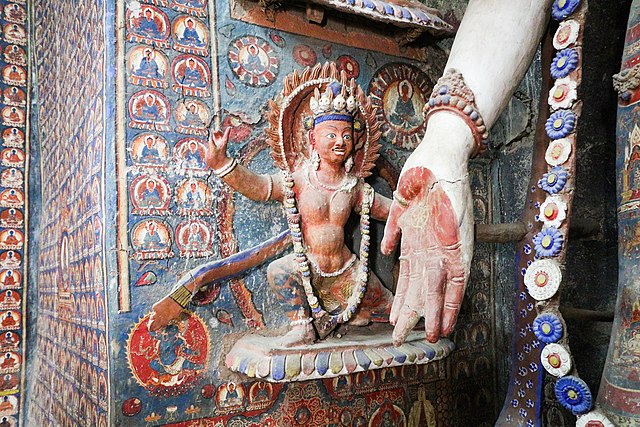
Tips for Visiting Alchi Monastery: Dress Code, Photography, and Etiquette
Dress Modestly and Respectfully
When visiting Alchi Monastery, it is important to dress modestly and respectfully. This means covering your shoulders and knees. It is considered disrespectful to wear shorts or sleeveless tops when visiting the monastery. Visitors are expected to dress in a way that shows respect for the religious significance of the site.
Photography Rules at Alchi Monastery
Photography is allowed outside the monastery but not inside the prayer halls. You can take pictures of the beautiful scenery around the monastery and its surrounding landscapes. However, you must be respectful of those who are praying or meditating by keeping your voice low while taking pictures outside.
Inside the prayer halls, photography is strictly prohibited. The reason behind this rule is that these areas are considered sacred spaces where people come to pray and meditate. Taking pictures inside would be a distraction from their spiritual practices.
Remove Your Shoes Before Entering Prayer Halls
It’s customary to remove your shoes before entering any Buddhist temple or monastery in the Ladakh region including Alchi Monastery. This practice has been followed for centuries as it signifies leaving behind one’s worldly possessions before entering a sacred space.
Visitors should also be aware that some parts of the monastery may require them to remove their shoes as well. For example, if you want to enter an inner sanctum or private room within the monastery complex, you will need to remove your shoes as a sign of respect.
Do Not Touch or Disturb Any Religious Artifacts or Objects
Alchi Monastery houses many ancient artefacts such as statues, paintings, manuscripts etc., which hold great religious significance for Buddhists around the world. It is important not to touch any religious artefacts or objects during your visit as they are considered sacred items.
While exploring different parts of the Alchi Monastery complex make sure to maintain a respectful distance from these artefacts. It is also important not to disturb any of the monks or nuns who may be present in the area.
Keep Your Voice Low and Be Respectful of Those Who Are Praying or Meditating
It’s crucial to keep your voice low while visiting Alchi Monastery. This is because many visitors come here to pray and meditate, and loud noises can disrupt their spiritual practices. When you are inside the prayer halls, it’s essential that you speak in a whisper so as not to disturb anyone else around you.
Be mindful of others who may be praying or meditating around you. Try to avoid making any sudden movements or loud noises that could distract them from their spiritual practice.
Follow the Instructions of Local Guides or Monks
When visiting Alchi Monastery, it’s important to follow the instructions given by local guides or monks. They are there to ensure that visitors have a safe and enjoyable experience while at the monastery.
If you have any questions about what is allowed during your visit, ask one of the guides for clarification. They will be happy to help answer any questions you may have about the Alchi Monastery complex and its history.
Arts and Culture of Alchi Monastery: Glimpses of the Ancient World
The Rich History of Alchi Murals and Wood Carvings
Alchi Monastery is a treasure trove of Indo-Himalayan art that dates back to the 10th century. The intricate Alchi murals and wood carvings found at the site are some of the oldest surviving examples in the region, offering a glimpse into the ancient world.
The art and culture of Alchi Monastery have been shaped by artists and scholars from different periods. In particular, the early 13th century saw a significant influence on the gompa’s walls and carvings. These works reflect an amalgamation of Indian, Tibetan, and Kashmiri styles, showcasing various artistic traditions.
Rinchen Zangpo: A Scholar Who Left His Mark on Alchi Monastery
One of the most famous scholars associated with Alchi Monastery was Rinchen Zangpo. He is credited with bringing Buddhism to the region during his time as a translator in western Tibet. Rinchen Zangpo commissioned many images and carvings found at the site, leaving his mark on this cultural heritage.
Rinchen Zangpo also established several monasteries in Ladakh, including Lamayuru, Mangyu, Sumda Chun, Wanla, Basgo, Phyang, and Nyarma Gonpa among others. His contributions helped spread Buddhist teachings across the Ladakh region.
Depictions of Deities: Goddesses and Figures Associated with Religious Practices
The carvings and images found at Alchi Monastery depict a wide range of deities from Buddhist mythology. These include goddesses such as Tara (the female embodiment of compassion) and other figures associated with daily life practices like farming or hunting.
One notable event celebrated at Alchi Monastery is Chotrul Duchen which commemorates Buddha’s miraculous display of power. The festival is celebrated on the fifteenth day of the first Tibetan month and is one of the most important events in the Buddhist calendar.
Significance of Wall Paintings at Alchi Monastery: Iconography and Symbolism
Age and Preservation of Wall Paintings at Alchi Monastery
The wall paintings at Alchi Monastery are a significant part of the cultural heritage of India. These murals date back to the 11th century, making them some of the oldest surviving examples of Buddhist art in the region. Despite their age, these paintings have been remarkably well-preserved, thanks in part to the dry climate and remote location of the monastery.
Depiction of Buddhist Deities and Iconography
The murals at Alchi Monastery depict a wide range of Buddhist deities, as well as scenes from the life of Buddha and other religious iconography. These images are rich with symbolism and meaning, reflecting the complex beliefs and traditions of Indian and Tibetan Buddhism.
One particularly noteworthy feature of these wall paintings is their intricate details. The artists who created these murals paid close attention to every aspect of their subjects, from clothing and jewellery to facial expressions and body language. This level of detail makes it possible for viewers to gain a deeper understanding not only of Buddhist iconography but also of everyday life in ancient India.
Vibrant Colors on Side Walls
The side walls of Sumtsek temple are home to some particularly vibrant examples of wall painting at Alchi Monastery. These murals feature bold colours that have remained bright even after centuries exposed to sunlight. The use of colour is an essential element in traditional Indian art, representing different emotions, moods, or ideas.
In addition to being visually stunning, these side-wall paintings also provide valuable insight into the history and development of Buddhist art in India. They reflect a unique blend of Indian artistic traditions influenced by Hinduism with Tibetan Buddhism’s unique style.
Iconography Reflecting Indian-Tibetan Blend
The iconography present in the wall paintings reflects this unique blend of Indian and Tibetan Buddhist traditions. The murals depict a wide range of deities, many of which have roots in both Indian and Tibetan Buddhism. This blending of cultures is also reflected in the architecture of Alchi Monastery itself, which features a mix of Indian and Tibetan styles.
The wall paintings at Alchi Monastery are also significant because they provide insight into the development of Buddhist art over time. Scholars can use these murals to trace the evolution of different artistic styles and techniques, as well as to gain a better understanding of how Buddhist beliefs and practices changed over time.
Importance of Monasteries
Monasteries like Alchi are essential for preserving cultural heritage and passing on knowledge from one generation to the next. They serve as centres for learning, meditation, and worship, providing a space where people can come together to explore their faith and deepen their understanding of the world around them.
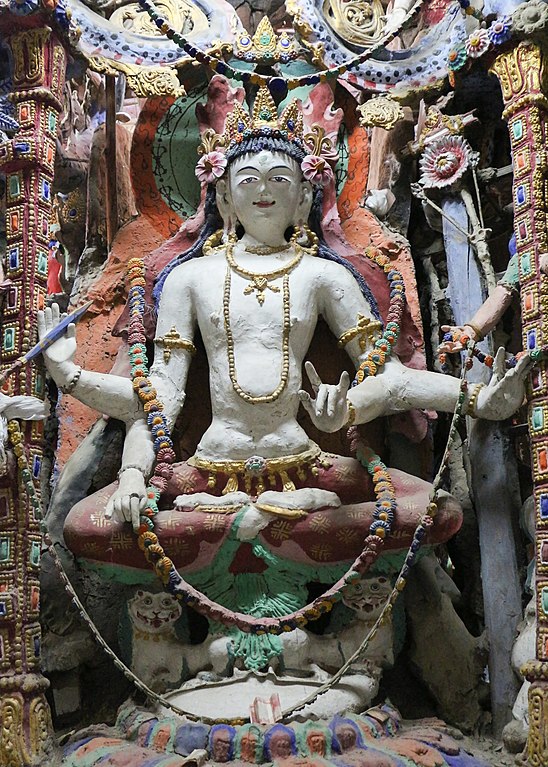
Preservation Efforts at Alchi Monastery: Challenges and Achievements
Preservation efforts at Alchi Monastery have been ongoing for many years, with the goal of protecting the unique artwork and architecture of this ancient site from further damage or deterioration. However, these efforts have faced significant challenges due to the age of the structures and the harsh weather conditions in the region.
Challenges Faced in Preserving Alchi Monastery
One major challenge in preserving Alchi Monastery has been maintaining the structural integrity of the buildings. Many of these structures are hundreds of years old and were built using traditional methods that do not always hold up well over time. Erosion caused by wind and water has caused significant damage to some parts of the monastery, making it difficult to keep them safe from further harm.
Another challenge has been protecting the artwork and manuscripts housed within the monastery’s walls. These pieces are incredibly valuable both historically and artistically, but they are also fragile and susceptible to damage from exposure to light, moisture, or fluctuations in temperature. This means that special care must be taken when handling or displaying them.
Achievements in Preserving Alchi Monastery
Despite these challenges, significant progress has been made in preserving Alchi Monastery over recent years. One major achievement was the restoration of the main temple complex, which was completed in 2018 after several years of work. This project involved repairing damaged walls and roofs as well as restoring many of the intricate paintings that adorn the interiors.
Another important preservation effort has been digitizing many of the monastery’s ancient manuscripts and artwork. This process involves creating high-quality digital copies that can be stored safely away from potential environmental hazards while still allowing scholars and researchers access to their contents. This effort helps ensure their long-term survival while also making them more widely available for study.
Ongoing preservation efforts include monitoring for signs of wear or damage to structures throughout the monastery grounds, as well as taking steps to protect the artwork and manuscripts from further harm. This might involve installing new climate control systems or improving the storage conditions for these fragile pieces.
Experience the Serenity and Spirituality of Alchi Monastery in Leh Ladakh
Alchi Monastery is a hidden gem located in the heart of Leh Ladakh, India. This renowned Buddhist monastery is known for its serene and spiritual ambience that attracts visitors from all over the world. If you’re looking for a place to relax, unwind and connect with your inner self, then Alchi Monastery is the perfect destination for you.
A Glimpse into History
Alchi Monastery is one of the oldest monasteries in the region and dates back to the 11th century. It was founded by Rinchen Zangpo, a famous translator who introduced Buddhism to Tibet. The monastery served as a learning centre for Buddhist scholars and monks who came from far and wide to study here.
The monastery’s architecture reflects an amalgamation of Indian and Tibetan styles, with intricate carvings and paintings adorning its walls. The main temple houses three large statues of Buddha along with other deities. Visitors can spend hours admiring the intricate details on the walls that depict various Buddhist deities and scenes from Buddha’s life.
A Spiritual Haven
Alchi Monastery offers visitors a unique opportunity to experience spirituality at its best. The peaceful surroundings make it an ideal place for meditation, contemplation, and introspection. The monastery also has a guesthouse where visitors can stay overnight or for several days to immerse themselves in this serene environment fully.
The monks at Alchi Monastery are friendly and welcoming towards visitors. They are happy to answer any questions about Buddhism or their way of life. Visitors can also participate in prayer sessions or witness traditional ceremonies performed by the monks.
Explore Local Culture
Apart from experiencing spirituality, visitors can also explore nearby villages around Alchi Monastery to get an insight into the local culture and traditions of Himachal Pradesh. These villages offer a glimpse into rural life in India, with their vibrant markets and colourful houses. Visitors can also try local delicacies such as momos, Thukpa, and butter tea.
Frequently Asked Questions about Alchi Monastery: Your Queries Answered
If you’re planning a trip to Leh Ladakh and looking for a serene and spiritual experience, then Alchi Monastery is a must-visit destination. In this section, we have answered some of the frequently asked questions about Alchi Monastery to help you plan your visit better.
History of Alchi Monastery: A Glimpse into the Rich Cultural Heritage of Leh Ladakh
Alchi Monastery is one of the oldest monasteries in Ladakh, dating back to the 11th century. It was built by Rinchen Zangpo, a famous translator who introduced Buddhism to Tibet. The monastery is known for its ancient wall paintings that depict various Buddhist deities and scenes from the life of Buddha.
The Architecture of Alchi Monastery: A Marvelous Blend of Indian and Tibetan Styles
The architecture of Alchi Monastery is unique as it blends Indian and Tibetan styles. The monastery has three main temples – Dukhang (Assembly Hall), Sumtsek (Three-storeyed Temple), and Manjushri Temple. The temples are adorned with beautiful wood carvings, frescoes, and statues.
Best Time to Visit Alchi Monastery: Climate, Festivals, and Crowds
The best time to visit Alchi Monastery is from June to September when the weather is pleasant. However, if you want to witness the famous Hemis Festival, which takes place in July-August every year, then plan your visit accordingly. Keep in mind that during peak season (June-August), the monastery can get crowded.
How to Reach Alchi Monastery: Distance from Leh and Transportation Options
Alchi Monastery is located at a distance of around 70 km from Leh. You can hire a taxi or take a bus from Leh to reach there. The journey takes around 2-3 hours, depending on the road conditions.
Tips for Visiting Alchi Monastery: Dress Code, Photography, and Etiquette
When visiting Alchi Monastery, it is important to dress modestly and remove your shoes before entering the temples. Photography is allowed but make sure to ask for permission before clicking pictures. Also, maintain silence and respect the monks and their way of life.
Arts and Culture of Alchi Monastery: Glimpses of the Ancient World
Alchi Monastery is known for its ancient wall paintings that depict various Buddhist deities and scenes from the life of Buddha. These paintings are a testament to the rich cultural heritage of Ladakh and offer a glimpse into the ancient world.
Significance of Wall Paintings at Alchi Monastery: Iconography and Symbolism
The wall paintings at Alchi Monastery have great significance as they depict various Buddhist deities and their teachings. The iconography and symbolism used in these paintings offer insights into Buddhist philosophy and spirituality.
Preservation Efforts at Alchi Monastery: Challenges and Achievements
Preserving ancient monuments like Alchi Monastery is a challenging task. However, with the efforts of local communities, NGOs, and government agencies, significant progress has been made in preserving this cultural heritage site.
Experience the Serenity and Spirituality of Alchi Monastery in Leh Ladakh
Visiting Alchi Monastery is not just about seeing an ancient monument but also about experiencing serenity and spirituality. The peaceful atmosphere of the monastery can help you connect with your inner self.
Conclusion: Discover the Serenity and Spirituality of Alchi Monastery in Leh Ladakh
In conclusion, if you’re looking for a serene getaway that offers glimpses into ancient culture and spirituality, then visit Alchi Monastery in Leh Ladakh. With its unique architecture, ancient wall paintings, and peaceful surroundings, it’s a must-visit destination. So, pack your bags and embark on a journey of self-discovery!
If you are looking to book a camp resort in Leh, please contact 9818824450 or email us at info@bikamp.com

